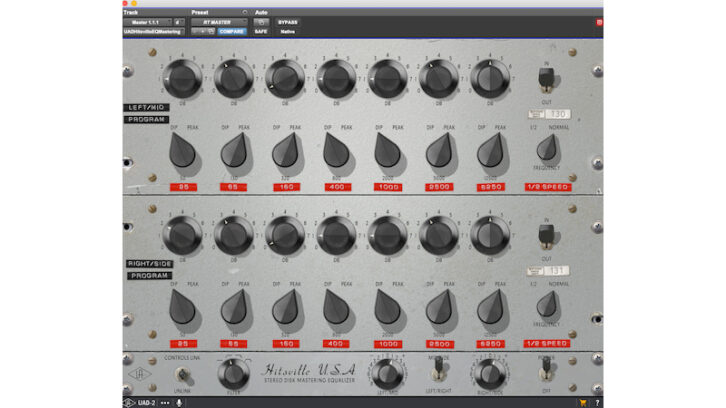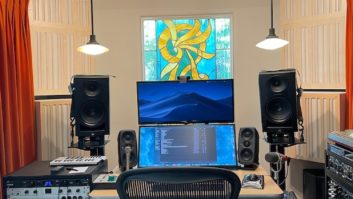
| MIX VERDICT: UA Hitsville USA EQ Collection |
| THE TAKEAWAY: “How does it sound? Well, it’s like adding a pat of butter to your lobster. It just makes things better in a soft yet clearly definable way.” |
| COMPANY: Universal Audio • www.uaudio.com PRICE: $299 for Apollo and UAD; $19.99/mo as part of Spark subscription PROS: • Undeniably superb sound CONS: • No metering or custom selectable frequencies |
Hitsville USA is the awesome name given to the first Motown house/recording studio and headquarters in Detroit, Mich. Purchased by Motown Record Corporation founder and music lover Berry Gordy in 1959, it launched an amazing number of world-class artists and hit records into the stratosphere. With a list that includes The Supremes, Stevie Wonder, Smokey Robinson, The Temptations, The Jackson 5, Diana Ross and many others, the Hitsville studio spurred an iconic, soulful sound that has warmed souls for generations.
But how about that sound? Aside from the undeniable talent and songwriting, the records evoked a timeless sonic feel that we all could use a taste of. Luckily for us, Will Shanks and the team at Universal Audio worked with Motown alumnus/technical engineers on the emulation of these units, which were designed specifically for the Motown studio. They modeled the entire electronic path, including the amplifiers, transformers, EQ band interactions and internal clipped filter distortion. They also used reference units from Michael Brauer, Jesse Gay, George Peterson and those in the Motown Museum’s collection.
Universal Audio has a well-respected track record of taking vintage pieces of studio gear and turning them into plug-ins we can all use on our desktop. This Hitsville EQ falls squarely into that category of “I don’t know how you did it, but I’m damn glad you did.”
STUDIO AND MASTERING
Hitsville USA is really two plug-ins—an EQ that was used in the studio, and a separate Mastering version, which was used for a cutting lathe in preparing vinyl releases. The collection will work with the Apollo/UAD hardware platform on Mac and Windows, but also includes a UAD Spark version. Spark native Mac versions, which don’t require UA hardware, are installed independently on the UA Connect app.
The Studio EQ, of which 46 units were made, features seven discrete, rotary inductor–based, proportional Q, fixed frequency bands, with ±8 dB of boost or cut. Each of the overlapping bands has optional “tape” labeling above them for Sub (50 Hz), Bass (130 Hz), Lo Mid (320 Hz), Mid (800 Hz), Hi Mid (2,000 Hz) and Hi (12,500 Hz). The tape labels can be switched on/off by clicking on the property badge to the right of the master Gain knob, which also provides ±8 dB of boost or cut. There’s also a switch next to that for In, Out and Off.
Onkart Gromt Grompressor – A Real-World Review
In makes the EQ frequencies active; Out will still run it through the amps and heavy-duty United Technologies Corporation and Freed input/output transformers; and Off is fully off with a hard bypass. As mentioned, the frequencies themselves are fixed, but the boost/cut is discrete in 1 dB steps. Note that if you click on the Hitsville USA logo, the knobs will zero out, so pay attention to that feature.
The Mastering EQ, of which only six were made, also features seven bands and full stereo control with mid/side operation for independent control of the mono/stereo image. Stereo channels can be processed individually, or linked and unlinked with the Controls Link switch. Dip/Peak switches let you select each frequency as needed, and the Mid/Side and Left/Right switches let you toggle between the two choices.
Interestingly, it features the ability to run half- speed, which effectively halves the associated frequencies (for example, 50 Hz will run at 25 Hz). This feature was originally designed for disc mastering, where the engineer would EQ the music at normal speed, but then run the tape machine, vinyl lathe and equalizer at half-speed, in order to achieve more overall detail. There’s also a Filter knob that emulates Hitsville disc-cutting filters. Settings are No Filter, 70 Hz highpass, 15 kHz lowpass and a combined 70 Hz/15 kHz bandpass filter.
Enough of the technical talk, how does it sound? Well, it’s like adding a pat of butter to your lobster. It just makes things better in a soft yet clearly definable way.
FINDING THAT SOUND
I like that it is a visual representation of the EQ, which lets you use nothing but your ears and taste. With the fixed Q and unique interaction between bands, you just jump in there and start turning knobs on your track or mix. If you do need to boost, you can get creative and cut the frequency bands around your chosen band. Again, your ears will do all the work here, not your eyes.
I use this plug-in to cut as much as I do to boost. As a TV composer, I particularly like the studio EQ to soften the edge of direct electric guitars, cutting 5,000 Hz and nudging up the mid-mid 2,000 Hz with a few dBs of overall gain. You can add a warm sense of air to string libraries, pads and drum overheads by boosting 12,500 Hz and 130 Hz. I have a lot of EQs and use them all, but this one has its own sense of character that is hard to define in words. It’s amazing how far you can turn these knobs with no ill artifacts in the sound. It just works.
The Mastering EQ is a whole different animal from the same family. I had my mastering EQ chain down for years, but this has managed to slip in there because my mixes are simply warmer in a musically delicious way, with the full access to mid/side processing. Trust me, if you crank up 25 Hz, you’re going to fill up your bottom!
With that in mind, I find boosting 65 Hz and cutting a touch of 25 Hz adds just the right amount of low cream. Also, adding 12,500 Hz on the left/right mix and rolling off a bit of 15 kHz on the master can make it smooth like old tape. Just put Steve Levine’s “Mix Just Sounds Better” preset on, tweak a bit and, yes, it just sounds better!
Aside from my thoughts, I felt that a touch of perspective would be in order here. I reached out to a few industry friends for their take on the EQ. “For me, UA’s Hitsville EQ is a true character piece,” said mixer/engineer Richard Chycki (Rush, Evanescence, Aerosmith, Dream Theater). “It’s not surgical at all; it’s vibe all the way! I’ve found it particularly useful for adding vintage-y flavor to vocals, guitars, snare drums and overheads.”
Mark Everton Gray (Imagine Dragons, Joe Bonamassa, The Killers) added, “As soon as you put the Hitsville EQ on an insert, it instantly adds character. I applied it to a project I was about to finish—which is very dangerous—and it just made the midrange stand out in a way that I was looking for, but was missing. Hitsville was my missing link. I won’t work without it from here on out.”
Engineer/mixer Peter Moshay (Live From Daryl’s House, Hall & Oates, Mariah Carey) also had a good take on it: “Hitsville differentiates itself sonically, but still sounds killer. The density it brings is really good without being over the top, and it adds just enough thickness to ‘enhance,’ not ‘transform,’ your track.”
My sentiments exactly!







